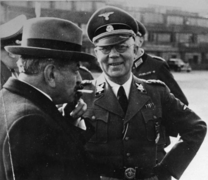Carl Oberg's Human Design Chart
1/3 Emotional ManifestorCarl Oberg: A Complex Figure in History and Human Design
Introduction
Carl Oberg, a German SS functionary, played a significant role during the Nazi era as the Higher SS and Police Leader (HSSPF) in France during World War II. Known for his controversial actions and impact, Oberg’s life was marked by his Human Design as a Manifestor. His unique design influenced his decisions and the legacy he left behind.
Early Life and Career
Born on January 27, 1897, in Hamburg, Germany, Carl Oberg grew up in a time of political turbulence and rapid change. As a young man, Oberg’s Manifestor type began to shape his path, characterized by his natural ability to initiate and influence. His Emotional Authority meant he often made decisions based on his feelings at the moment, a trait that would later define his career.
World War II and Role in France
During World War II, Oberg served as the Higher SS and Police Leader of France, a position that allowed him to execute his strategic approach as per his Human Design strategy: to inform. This strategy played a part in the deportation of over 40,000 Jews from France, a decision that reflected his Emotional Authority and his Profile of 1/3, which embodies a trial-and-error learning process.
Human Design: The Manifestor
Carl Oberg’s Human Design as a Manifestor is critical in understanding his life choices and leadership style. Manifestors are known for their ability to initiate action and create impact. Oberg’s Emotional Authority guided him to make decisions often in the heat of the moment, profoundly affecting the outcomes of his actions during the war.
His Profile of 1/3 indicates a personality prone to investigation and experimentation, which can be seen in his strategic operations and the ways he navigated his role within the Nazi regime. The Incarnation Cross of the Right Angle Cross of The Four Ways (19/33 | 44/24) suggests a life path focused on significant directional shifts and transformation, which Oberg experienced through his controversial wartime decisions and their aftermath.
Post-War Sentencing and Release
After World War II, Carl Oberg faced significant consequences for his actions. He was twice sentenced to death by different courts for his role in the Holocaust. However, in 1958, his sentence was commuted to life imprisonment and later reduced to 20 years of hard labor. Oberg’s eventual pardon by President Charles de Gaulle in 1962 and subsequent release align with his Human Design’s potential for unexpected change and transformation.
Later Life and Death
Carl Oberg spent his later years in relative obscurity after his release. He passed away in Flensburg on June 3, 1965, at the age of 68. His life, marked by his Manifestor attributes and emotional decision-making, leaves a complex legacy that continues to be studied and debated.
Legacy and Reflection
The life and actions of Carl Oberg remain a subject of intense scrutiny and analysis. His Human Design as a Manifestor with Emotional Authority provides a lens through which his decisions and leadership can be understood. While his role during the Nazi era casts a dark shadow, Oberg’s Human Design points to a deeper understanding of his motivations and life path.
Frequently Asked Questions
What is Carl Oberg’s Human Design?
Carl Oberg was a Manifestor with Emotional Authority, and his Profile was 1/3. His Incarnation Cross was the Right Angle Cross of The Four Ways (19/33 | 44/24).
How did Carl Oberg’s Human Design affect his actions during World War II?
As a Manifestor, Oberg had a natural ability to initiate and influence. His Emotional Authority meant he often made decisions based on his feelings, impacting his strategic operations in France and his role in the deportation of Jews.
Why was Carl Oberg pardoned?
Oberg was pardoned by President Charles de Gaulle in 1962, possibly due to political considerations and the changing climate of post-war Europe. This aligns with his Human Design’s potential for unexpected change and transformation.
Discover More Famous People
Browse and analyze over 55,000 public figures and celebrities.
Ra Uru Hu
5/1 Manifestor
Martha Stewart
4/6 Manifestor
David Lynch
4/6 Generator
Barack Obama
6/2 Projector
Steve Jobs
6/3 Generator
Vladimir Putin
5/1 Manifestor
Kim Kardashian
3/5 Generator
Michael Jackson
1/3 Projector
Marilyn Monroe
6/2 Projector
Ariana Grande
2/4 Projector
Oprah Winfrey
2/4 Generator
Johnny Depp
2/4 ManifestorWhat is HumanDesign.ai and how does it work?
Curious what makes Carl Oberg tick? HumanDesign.ai instantly maps their exact birth data into a fully interactive clickable bodygraph chart, letting you hover or tap every center, channel, and gate for plain-language explanations. Bella, the platform’s built-in AI guide, adds context in real time, translating complex mechanics into everyday insights so you can see how Carl Oberg’s strengths, challenges, and life themes play out on-screen.
The same tools are waiting for you. Generate your own Human Design Chart in seconds, open a library of 2000+ suggested questions, and chat with Bella as often as you like to decode your design, daily transits, and even relationship dynamics.
Want to compare energies? Save unlimited charts for friends, family, or clients, then ask Bella to reveal compatibilities, composite patterns, or coaching tips, all in one conversation thread.
Start free with core features, or unlock our Personal and Pro plans for deeper dives: unlimited Q&A, celebrity chart search spanning 55,000+ public figures, white-label PDF reports, branded content generation, and a professional profile with built-in booking for practitioners. Whether you’re exploring your own potential or guiding others, HumanDesign.ai delivers an ever-expanding toolbox of AI-powered insights—no spreadsheets, no jargon, just clarity at your fingertips.
Ready to see yours? Signup for FREE today!

